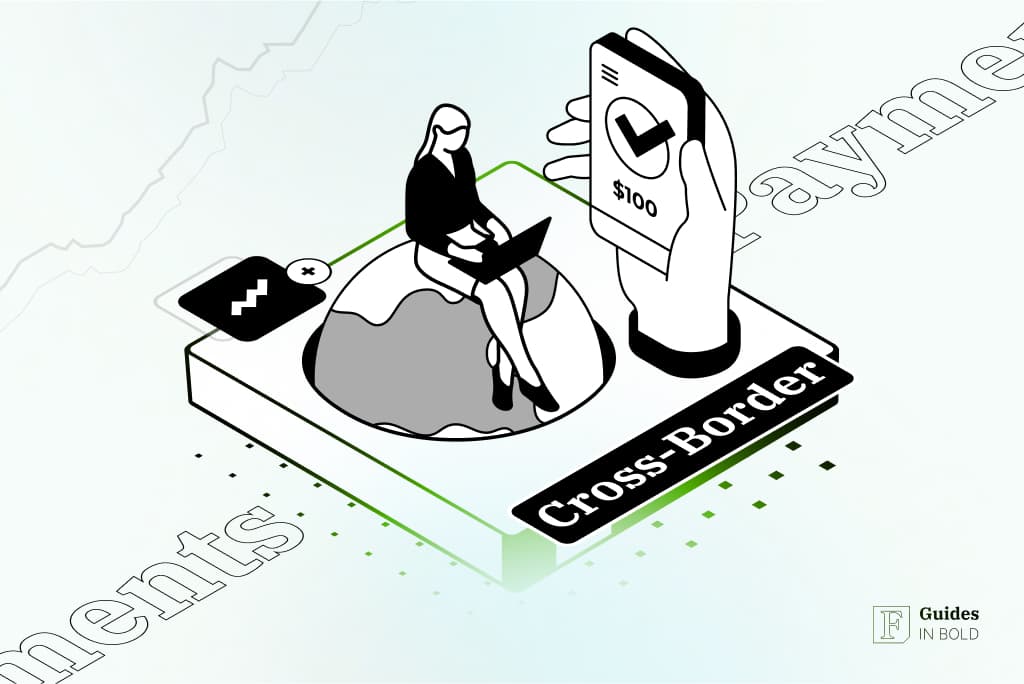Digital assets are changing how we handle cross-border payments, breaking down barriers that have long hindered international financial transactions. In this guide, we explore how these assets are democratizing global payments and making them accessible to everyone, regardless of their location or financial background.
The challenges of cross-border payments
Sending money across borders can be expensive, slow, and complex. Namely, traditional methods often involve high fees, as banks and remittance services impose significant charges for transactions and currency conversion. These fees can disproportionately impact smaller transfers, which consume a hefty portion of the total amount.
But that’s not all. Besides high fees, other problems include:
- Delays: Transfers often take several days to clear, especially in countries with less advanced banking systems;
- Limited access: Some developing countries lack international financial services, leaving people unable to send or receive money globally;
- Currency exchange hassles: Currency conversion includes additional fees and fluctuating exchange rates, making transactions unpredictable.
These are the main issues that make traditional cross-border payments less accessible to individuals and small businesses. Luckily, digital assets aim to change that.
What are digital assets?
Unlike traditional currencies or assets held in banks, digital assets operate on decentralized networks, ensuring transparency, security, and global accessibility. Their underlying blockchain technology eliminates the need for intermediaries like banks, which streamlines transactions and reduces costs.
However, digital assets are not limited to finance. They also include digital collectibles, utility tokens, and assets used in decentralized applications. Such a variety offers various uses, from everyday payments to more specialized functions.
Here’s how digital assets compare to traditional cross-border payment methods:
| Feature | Traditional methods | Digital assets |
| Fees | High (banks, remittance fees) | Low to negligible |
| Speed | Days | Minutes |
| Accessibility | Limited to banked individuals | Global and inclusive |
| Transparency | Low | High (blockchain ledger) |
| Exchange rate fluctuations | Frequent | Minimal (with stablecoins) |
How do blockchain and digital assets solve the problems of cross-border payments?
Digital assets are optimally equipped to address the challenges of traditional payment systems. They can make cross-border payments more accessible through:
- Lower transaction costs: Blockchain networks operate without intermediaries like banks, which significantly reduces transaction fees, especially for microtransactions or payments to remote regions;
- Speed: Blockchain-based transactions often settle within minutes, providing near-instant payment processing, unlike traditional transactions, which can sometimes take days;
- Global reach: Anyone with internet access can use digital assets to send or receive money, even in regions without robust banking infrastructure. This inclusivity empowers the unbanked population;
- Transparency and security: Blockchain technology creates an unchangeable ledger of all transactions, reducing fraud and building trust in financial dealings;
- Simplified currency exchange: Pegged to a fiat currency like the US dollar, stablecoins offer consistency in value while retaining the benefits of blockchain technology.
Real-world use cases of digital assets
Digital assets are transforming cross-border payments in various sectors. One significant use case applies to financial transfers, where migrant workers send money home. Unlike traditional methods with high fees and delays, digital assets enable fast, low-cost transfers, ensuring families receive more funds for essential needs.
On the other hand, small and medium-sized enterprises (SMEs) also benefit from digital assets. With blockchain-based payments, SMEs can participate in international trade with fewer overheads, fostering growth and innovation in underserved regions.
Furthermore, in crisis-hit regions, where banking infrastructure is often unreliable, digital assets enable aid organizations to deliver funds directly to beneficiaries quickly and transparently. This bypasses delays and reduces the risk of mismanagement.
Last but not least, freelancers and remote workers also use digital assets for cross-border payments. These systems eliminate high fees and delays common in traditional methods, allowing workers to receive payments quickly and reliably.
What platforms make cross-border payments more accessible?
Among various platforms that practice democratizing digital asset payments, Ka.app stands out as a user-friendly solution. Part of its aim is to provide secure, low-cost, and fast cross-border payments.
Besides that, Ka.app is also a solid option due to:
- Easy to use: Ka.app’s interface makes it accessible to users of all tech skill levels;
- Fast and secure transactions: Ka.app strives to ensure safe & secure payments within minutes;
- Low fees: Ka.app continues to place focus on transaction costs;
- Compliant: Ka.app also places an ongoing focus within the continuously evolving regulatory and compliance landscape, and currently holds VASP licenses within Bulgaria, Italy, and Lithuania.
Disclaimer: Investing in crypto-assets carries significant risks, including volatility, potential total capital loss, fraud, cyberattacks, and irreversible transactions. Regulations vary by jurisdiction; consult local laws before proceeding including within areas such as but not limited to local prohibitions, tax obligations, and investor protections. Only invest funds you can afford to lose. Additionally, for European Union residents: Crypto-assets are not covered by EU investor compensation schemes. Platform or partner insolvency may result in irrecoverable losses. Certain crypto services may operate under national transitional rules (not MiCA authorization). In such cases, MiCA safeguards on asset protection do not apply.
The impact of digital assets on financial inclusion
Many people worldwide are unbanked, lacking access to essential financial services like savings accounts, credit, and cross-border payments. Digital assets address this by providing an alternative that requires only a smartphone and internet connection.
In many developing countries, traditional financial institutions are concentrated in urban areas, leaving rural populations with few options. Digital assets, powered by blockchain technology, allow anyone to participate in the financial system regardless of their location.
Additionally, digital assets reduce reliance on costly intermediaries, allowing individuals to save more of their earnings. For example, people sending payments abroad can avoid excessive fees.
With this in mind, it’s safe to say that by making financial services accessible, affordable, and inclusive, digital assets are not just reshaping payments but empowering people to participate in the global economy.
What are the challenges of using digital assets in cross-border payments?
While digital assets offer significant benefits for cross-border payments, they are not without challenges that could potentially slow down their broader adoption.
One of the most pressing issues is regulatory uncertainty. Different countries have varying rules and attitudes toward digital assets, with some embracing their potential and others imposing strict regulations or outright bans. This lack of common regulatory framework creates confusion for users and businesses, making it sometimes difficult to comply with requirements.
On the other hand, the limited understanding of blockchain technology and digital assets among the general population is another challenge. Many potential users lack the technical knowledge or even confidence to use digital wallets and blockchain platforms, which can be intimidating for crypto newbies.
Volatility is also a significant concern, particularly with cryptocurrencies like BTC and ETH, which are subject to price swings. While stablecoins address this issue by pegging their value to fiat currencies like USDT with the US dollar, their adoption is still growing and not universally available in all regions.
Finally, the lack of infrastructure in certain areas, such as internet access or reliable digital wallet providers, also limits the potential of digital assets.
The bottom line
Digital assets have changed how money moves globally. They are removing barriers like high fees, long delays, and limited access, as well as democratizing finance and making cross-border payments more accessible.
Regardless of whether you’re an individual sending money to others, a business trying to expand internationally, or maybe someone without access to traditional banks, digital assets seem like the right choice for you, with platforms like Ka.app and others offering a solid option for sending and receiving these conveniently, securely, and fast.
Disclaimer: The content on this site should not be considered investment advice. Investing is speculative. When investing, your capital is at risk.
FAQs on how digital assets are making cross-border payments accessible
What are digital assets?
Digital assets are any form of value stored digitally, such as cryptocurrencies and stablecoins. They operate on decentralized networks, enabling fast, secure, and transparent financial transactions without the need for intermediaries like banks.
How do digital assets make cross-border payments cheaper?
Digital assets eliminate intermediaries, such as banks and remittance companies, which often charge high fees. Blockchain technology allows transactions to happen directly between users, significantly reducing costs.
What makes blockchain faster for cross-border payments?
Blockchain is faster for cross-border payments because it eliminates intermediaries like banks, allowing transactions to be processed directly between users and settled within minutes on a decentralized network.
Are digital assets secure for international transactions?
Yes, digital assets are secure. Blockchain technology creates an immutable ledger of transactions, reducing the risk of fraud and ensuring transparency.
What is the best platform for cross-border payments?
Among various platforms, we find Ka.app to be a secure and user-friendly platform that provides fast cross-border payments.




